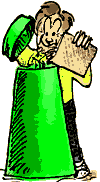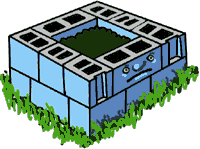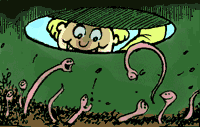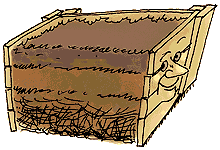Compost
Compost is a decomposed mixture of household leftovers and garden scraps. It makes a great natural plant food and doesn't cost a thing. Compost will improve any type of garden soil and it won't harm your plants. It's great stuff and well worth the effort.

- There are lots of composters that you can buy at garden or hardware stores.
- Ask an adult to help you choose a sunny spot that gets some exposure to rain, which will help break down the plant material.
- Pick a spot close to the edge of your garden or yard but not too close to your house.
You might want to make your own composter or start a compost pile. They are simple. Try one or more of the following:
- Make a tube of fine chicken wire or snow fencing.
- or... Make a wooden box with no top or bottom.

- or... Make a square of concrete blocks or bricks, leaving a few small gaps to let air flow through.
- or... Use an aluminum garbage can with some holes cut in and around the bottom to let excess moisture drain away.
Always ask an adult to assist you if you are using their tools. Whichever type of composter you decide to make, they all have the same requirements:
- Make some holes in the composter at ground level or near the bottom to allow air to circulate through the pile.
- Bury the bottom of the container at least 12 inches (30 cm) in the ground to prevent animals from digging under and into it.
- Lay on a 6-inch (15 cm) base of twigs, brush, and other coarse garden refuse to help air reach the bottom of the pile.
- Spread on 4 to 6 inches (10-15 cm) of kitchen and garden refuse: leaves, grass or hedge clippings, eggshells, coffee grounds, tea bags, vegetable peelings, hay, and fruit scraps.
- Don't compost meat scraps or bones, fish, or grease; they will attract unwanted animals and insects.
- To help compost rot faster, add a little manure or fertilizer and a shovelful of soil each time you put in about a shovelful of compostable materials.
- Don't add too much green stuff all at once, like lettuce, or it will get slimy and smelly.

- Occasionally sprinkle the pile with water just to wet it a little. Don't flood it!
- In a few days, thepile should begin to get warmer. In cold weather, you might even see steam rising from the pile.
- If you need to speed up the composting so it will be ready to use in 4 weeks, turn the pile with a garden fork every 2 or 3 days.
- You could start a new pile beside the existing one and move all the material from one pile to the other. Rotate the less rotted stuff from the side to the middle of the new pile.
- A pile that hasn't been turned over should be ready in a year.
- Compost is ready to use when the mixture has cooled, turns dark brown, and is crumbly.

- Note: A properly made compost pile shouldn't offend your nose. If your pile smells awful, fork it apart and repile it because it needs more airflow.
Fascinating Facts!
- Composting can help reduce the amount of waste sent to landfills. In the United States alone, more than 20% of landfill waste is food scraps and yard trimmings that could be composted instead.
- The ancient Greeks and Romans used compost to fertilize their crops. They would collect and mix animal manure with straw and other organic materials to create a nutrient-rich soil.
- Composting can help reduce greenhouse gas emissions. When organic waste is sent to landfills, it produces methane, a potent greenhouse gas. Composting helps to reduce these emissions by diverting organic waste from landfills.
- Composting can be done on a small scale, such as in a backyard compost bin, or on a large scale, such as at a commercial composting facility. Commercial composting facilities can process tons of organic waste per day!
- Composting can help attract beneficial insects and organisms to your garden, such as earthworms, which can help improve soil quality and plant growth.
planting
soil conditioning
|





